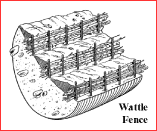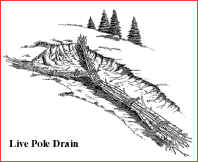| Forest Road Deactivation Practices | |
| in the Pacific Northwest | |
| 5 - Revegetation | Application Methods, Bioengineering |
One of the easiest means of seeding deactivated roads is hand broadcast seeding using a cyclone type spreader. However, where long stretches of deactivated roads must be seeded, helicopter broadcast seeding is the most cost-effective means of applying seed and fertilizer. Dry seed and fertilizer can be mixed in the application hopper. Hydro-seeding can be an effective, although costly means of applying seed and fertilizer. Where vehicle access is possible, a truck mounted hydro-seeder can be used effectively with a tackifier to treat steep cut slopes. Beyond full pullback or in areas otherwise inaccessible, heli-hydroseeding can be effective for steep sites although costs are high. Avoid the over-application of mulch (more than 400 kg/ha).
The nutrient and moisture status of deactivated roads must be taken into consideration when selecting species for planting. Typically, low nutrient levels as well as poor moisture holding capacity result in poorer site conditions than on the adjacent cutblock. Red or sitka alder fix nitrogen and can add substantially to improving the nutrient levels of deactivated roads. Companion planting, where alder is used to assist the growth of appropriate conifers, can be a suitable silvicultural pre-scription for deactivated roads. Moisture conditions can be improved in a similar way through the growth of pioneering species such as willow, poplar, alder and others.

Vegetation should be established when weather conditions are favourable. Typically, temperatures warm enough to allow physiological activity combined with ample moisture levels are the best periods for immediate growth of vegetation. Early spring seeding can be very effective, but access may be difficult (spring breakup). Mid-August seeding works well in many settings, while late fall seeding of Interior sites will allow the seed to remain dormant until the following spring. Early spring or mid-fall planting can be very effective in most areas as even minor vegetative cover reduces surface erosion. Moisture must be available for plants to survive. Where work is ongoing, seed completed sites at the most appropriate time relative to weather conditions, to provide the best results. This leaves a relatively small final seeding at the conclusion of large projects.

Soil bioengineering can be very effective in treating excessively steep sites. Bioengineering is the use of living plant materials to create an engineered structure. Short retaining walls (wattle fences above) or drains (live pole drains left) built of willow, cottonwood, and red osier dogwood cuttings, can stabilize over-steepened or seepage sites. Modi-fied brush layers can be used to treat ravelling sliver fills. In some situations, brush layers using full length cuttings (3 to 4 m) can be inserted into backfill material to permit slopes in excess of 100 %.
| 5 - Revegetation |
| Next |
||
|
Revegetation 5
|
|
|
©1999 - 2002 Flip Productions Limited Used with permission by CulvertBC |